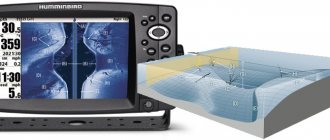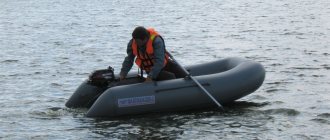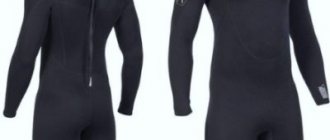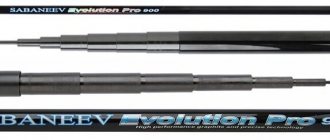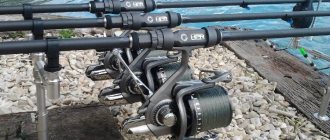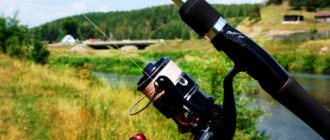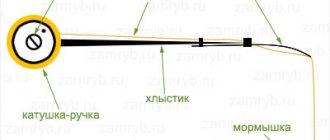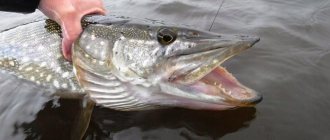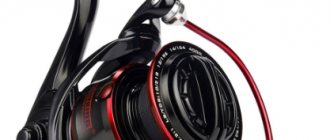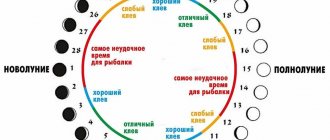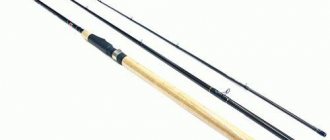Norstream Holiday
Average cost - 3,240 rubles.
Cheap and high-quality option for fishing. The rod is well balanced, light, with a length of 7 m weighing 270 g, with a length of 5 - 200 g. Designed for catching small fish weighing 1 - 1.5 kg using light equipment. True, you will have to finish it a little on the knee - it is better to additionally strengthen the tip of the top with glue and wrap it with thread. But at a low price this is not a disadvantage.
Volzhanka Modern
Cost, on average - 2,344 rubles.
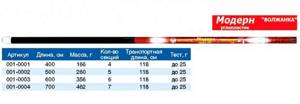
In fifth place in the ranking of the best fly rods is a lightweight, plastic telescopic model of good quality. It is very convenient for her to hook fish, as the swing is light and sharp. Excellent sensitivity when playing. At the same time, the high safety margin makes Volzhanka Modern one of the best offers in its price range.
Sabaneev Evolution
On average, you can buy it for 11,240 rubles.
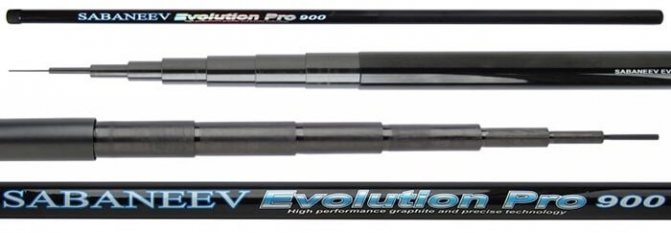
The review of fly rods continues with a line of powerful and tough models that are deservedly popular among post-Soviet fishermen. Durable and rigid rods retain the sporting spirit of “Italian” rods. They are perfect for using heavy and medium-heavy gear, they will easily overpower large fish, and fishing with a jig with a side nod is also possible.
Fishing with a fly rod
The most important thing in fly fishing is proper feeding of the fish. The first bait is usually used to attract fish to a certain place. But then it is very important to maintain a balance of bait so that there is no overfeeding and at the same time pieces of bait regularly settle through the water column, preventing the fish from getting bored.
You can use purchased or homemade masses as bait. Their main property is their strong odor. You must include some bait material (chopped worms, crushed corn) into the bait. Do not use too rich porridges so as not to feed the fish. Pearl barley and millet are best suited. And as attractants you can use various hot seasonings from the store or honey, dill, garlic, anise, hemp and vegetable oils.
Baits should be used taking into account seasonality: in the warm season, fish are more willing to take plant food (crumbs, peas, corn, boilies), and in the cold season, animal food (maggots, insects, larvae, worms).
When using bait, it bites best at the bottom, but you can try placing hooks in the water column and near its surface. With a suspended hook, the bite is more pronounced, but the fish approaches more carefully and slowly.
The moment of hooking occurs when the float takes a long bite, goes to the side or completely drowns. This means that the fish has taken the bait in its mouth and needs to be hooked with a short movement of the whip up or to the side and up.
There is no need to pull the rod very hard when hooking: a 20-40 cm separation from the water float is enough. Usually at such moments, the entire game of the fish is completely transferred to the hand through the swing form, giving the fisherman great pleasure.
The hooking effect in case of a sudden bite can always be ensured by leaving the pre-float part of the fishing line in a slightly tense state. It should be taken into account that quite weighty specimens can also gather for bait, which can easily break the fly rod. In this case, you should change the tackle to a more powerful one.
Fishing for small fish with a fly rod takes place in a straight line, “in the hand”, and for medium-sized ones with small movements on the landing net. If you do come across a very large fish, then try, without breaking the rod, to bring it into shallow water or into thick grass and catch it there with a landing net. In any case, it is better to miss the fish than to damage expensive gear that is not suitable for it.
Black Hole Galaxy
On average, you can purchase it for - 5,520 rubles.

But the rods of this series from Black Hole, in contrast to the tenth place in the ranking of the best fly rods 7 meters long, have found their way to the hearts of anglers. The fishing rod, made of durable high-modulus graphite, is suitable for catching fish up to 3 kg. Despite its general rigidity, the model is distinguished by a soft whip - at first it may seem too thin, but on the water it works real miracles.
Fastening the fishing line
Fishermen began using fly gear for quite a long time and during this time they came up with many improvements, one of them was fastening the fishing line. The fishing line can be attached to the fly rod in two ways:
- using a special latch;
- no shock-absorbing or shock-absorbing end switch.
Structurally, the latch has a very simple structure - it is an ordinary plastic tube with a slot, and a fishing line is passed through the slot. This latch is fixed on the tip of the rod with a rigid fastener. Also, a second tube with a larger diameter is put on the whip, which secures the first latch.
Such a latch can be bought at any fishing store or market. Self-manufacturing of such a structure usually causes difficulties for fishermen, since the process is quite complex. So it’s better not to start making it yourself, and if you can’t buy such a retainer, then it’s better to use another option.

The fly rod can be equipped with a limit switch. End switches are usually divided into two types, based on their design features. Anglers differentiate between shock-absorbing and non-shock-absorbing fly rod ends.
- The shock-absorbing end cap is made from a piece of rubber, which is then wrapped with nylon thread. Usually this part of the tackle is about 40 - 100 millimeters long, and its diameter is only 2 millimeters. The fastening is a nylon thread, pre-treated with glue. A knot is tied at the end of this device. Then, for greater reliability, fishermen treat the knot and the attachment point to the rod with varnish.
- The end cap without a shock absorber is fixed on the rod in the same way, its only difference is its shorter length, it is only 20-30 millimeters. And it is not necessarily made of rubber; even a thin nylon cord can be used for production.
Milo Relix 2000
Average price - 9,500 rubles.
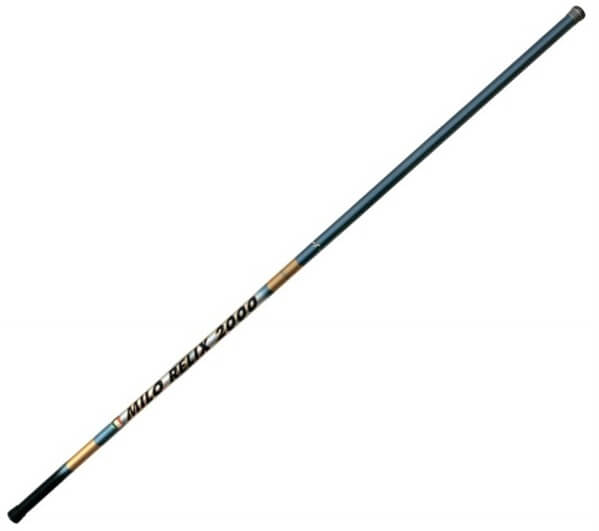
One of the most popular fly rods due to its excellent price/quality ratio. Due to the small diameter of the blank and the resulting ease, fishing with this rod is a pleasure. The structure is excellent, excellent balancing, no problems with fishing. However, due to its lightness, problems may arise when controlling the equipment in strong winds. Designed for fish weighing up to 2 kg (carp - up to 1 kg).
Choosing a fly rod
Bait 04/12/2019
Today in stores you can find many fishing rods of different prices and quality, that is, there is plenty to choose from. Quite often, the seller selects a fishing rod at the buyer’s request. When choosing gear, a conscientious sales consultant experiences no less difficulties than a buyer, since the latter most often simply cannot accurately formulate the purpose of the purchase - what kind of fishing this rod is needed for.
Length
First of all, the question of length arises. For catching live bait, bleak, gudgeon in a small river or crucian carp and roach in a pond, a 3 m long rod is sufficient. Fishing at a short distance is possible both in the spring, when the fish tends to the shore in warmer water, and in the summer, when it comes out to coastal vegetation for feeding.
Many people underestimate fishing “underfoot”. In my practice, there were many cases when fish were caught near the shore both better and larger than at a distance of 4 m or more. And catching bleak, gudgeon or perch with a rod longer than 5 m means admitting the inability to attract fish using bait and the inability to fish with accurate tackle.
If a 3-meter fishing rod is enough for fishing, and you take a 5-meter rod “with a reserve”, it is worth considering that if the rod is too long, an extra length of fishing line will appear and after casting you will have to drag the equipment to the fishing point. The line that is slack after pulling the float will begin to float on the wave and current, the hook will be delayed, and controlling the tackle will be difficult and often impossible. The number of overlaps and entanglements will inevitably increase both during casting and after hooking. In addition, each “extra” knee increases the weight of the rod, which greatly tires the hand. What’s even worse is that increasing the length of the rod automatically leads to an increase in the minimum weight of the equipment, otherwise it is simply impossible to cast it, especially in a headwind. Don't forget that a longer fishing rod costs more.
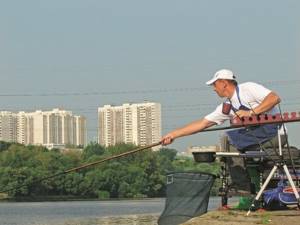
Optimal set
But what if you decide to go to another body of water where you need a longer rod? If you want to fish well, there is only one answer: buy the next rod, suitable for other fishing conditions. For fishing in different conditions, you need a certain set of rods that can be formed optimally.
Some fishermen consider the simplest option to be purchasing one rod as long as possible, which, depending on the fishing conditions, can be shortened by removing the required number of legs. In a number of cases this is convenient. But you will have to protect the ends of the sections after removing the butt joint and keep the rod constantly clean. The bad thing is that for long and light rods, the middle and upper sections are made without additional reinforcement, that is, the thickness and strength of the walls only require joint work with other sections. They are not designed for undistributed loads when squeezing the hand, which appear when fishing for large fish. Often, an angler simply crushes a section during the next power cast. This does not apply to rods made with a large margin of safety, designed specifically for catching large fish.
The exception is fly plug rods, which are designed to remove any section. However, purchasing a quality rod of this type is not easy. The small distribution of plugs is due to their fairly high price and the limitation in length to maintain good tuning, weight and power. If the length exceeds 7 m, the fly plug becomes excessively heavy. I know this well, since in my collection there are very good models with a length of 8 and 12 m.
If you constantly catch a variety of fish in different places, then a set of rods of unequal length will look something like this: two short rods 2.5 and 3.5 m long - for fishing near the shore, as well as 5-, 7- and 9-meter. Maybe, but only if it is really needed, a model with a length of 11–12 m will be added to them.
Power
Having decided on the length of the rods, you can start selecting specific models based on power. Power, strength and reliability must be separated, because although they are interconnected, there is no direct relationship.
The power of a fishing rod is determined not by the size of the intended catch (for this there is strength and reliability), but by completely different factors. Taking into account the fishing conditions, you will need equipment of one weight or another: in currents and depths, in strong winds - heavy, and when fishing in shallows and in calm conditions - lighter. As the fishing distance increases, heavier and heavier equipment will be required, and not only because of the increase in depth or strength of the current. The equipment must have a certain minimum mass so that it can be accurately thrown to the chosen location. The accuracy and casting distance are determined by both the weight of the equipment and the power of the rod. A fishing rod that is too rigid and heavy, despite all the efforts of the fisherman, will not be able to send light equipment even in calm weather. A rod that is too “light” in power will not allow you to accurately place the equipment at a distant fishing point.
Each rod has an optimal weight range of equipment for which it is designed. Most anglers pay attention to the recommended upper weight limit of the equipment, but I would pay more attention to the lower one. The fact is that now there are practically no rods on the domestic market that cannot be used with equipment weighing 15 and 20 g. In other words, the issue with the upper limit has been successfully resolved, and it is marked on the marking. Moreover, just in case, they put underestimated numbers. But the manufacturers can be understood, since the lower limit depends not only on the weight of the equipment, but also on the thickness and length of the fishing line, the shape of the float, weather conditions and on such a completely uncertain parameter as the technique of using the equipment by a particular angler. A thick fishing line sails and has very significant resistance. Pot-bellied floats fly much worse against the wind than elongated ones. The shorter the fishing line, the simpler and easier it is to cast light equipment, and vice versa.
How to choose a fishing rod based on power, even having a good idea of what equipment will be used, is probably the most difficult question. I am sure that it is better to take a less powerful model as it is more versatile. But here the next factor appears - the estimated size and strength of the fish. If you use a landing net and do not pull the fish out of the water over your head, the size of the trophy does not matter much, but the main thing is the resistance. Practice shows that if you catch fish weighing up to 1 kg, then any rod will hold up, but bringing a strong fish to the landing net on a soft rod can be troublesome.
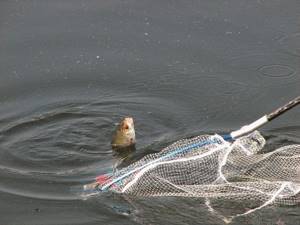
Build
The power of a rod, although not directly, is still connected with such a “slippery” concept as action. Determining the action of a fishing rod is not accurate. The reason is that flexible sections with variable cross-sections, especially those made of composite materials, cannot be accurately calculated. By the way, if you hear that a fishing rod was designed using some kind of supercomputer program, then this means that it was beautifully modeled based on existing full-scale samples. There is nothing bad in this; moreover, the Italian and English models are good because they embody a wealth of experimental material for the production of a wide variety of models. As for the action, it is important for us how accurately the rod sends the equipment to the fishing point and how the load is distributed in the sections of the rod while playing fish.
It is always more difficult to cast with a rod that is too flexible, even if the water is completely calm, but with it you can fish with the thinnest lines, exhausting very impressive specimens. A rod that is too rigid allows you to work as accurately and quickly as possible, but has limitations on light equipment. In addition, a large fish with one sharp jerk can tear off either a thin fishing line or its own lip. That is why in recent years, “bragging” about the modularity of carbon fiber in a fishing rod has lost both consumer and advertising meaning. For reference, I will say that for many years there have been carbon fibers several times higher modulus than those used in the production of fishing rods. It doesn’t occur to anyone to use them to create models that will be tougher than steel ones.
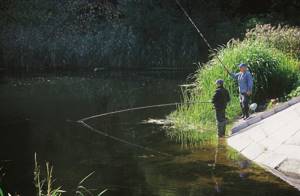
Strength
A compromise is found not only in rigidity, but also in the strength of the rods. Don’t think that a massive rod with thick walls will be more reliable. If you compare light and heavy fishing rods, then with a static load the difference will be visible and obvious. But in addition to static rigidity and strength, dynamic characteristics are more important. A more powerful and statically stronger rod is very easy to break in a strong headwind and even when sharply hooking a large fish. The rod will not have time to work and will break under the influence of its own inertia. To prevent this from happening, manufacturers have to use very high-quality and expensive materials, which means losing mass buyers. For example, elite fishing rods for sea fishing for trophy fish, made not from carbon, but from fiberglass, are really expensive. On the other hand, the lightest possible rod, made from the most modern materials, is also easy to break during a hard cast in a headwind or (which happens more often) when the equipment is caught in the bushes behind the angler’s back.
In the vast majority of cases, we choose a rod for ordinary, habitual fishing for small fish or, conversely, to catch carp, large chub or bream. The model you choose depends on what you're in the mood for. That is why all manufacturers have a line of rod offerings that differ not only in length, but also in power and rigidity. Almost all anglers sooner or later come to the conclusion that they replenish their arsenal by adding a rod for carp to the “five” for roach, a model for large chub to the “eight” for bream, and a plug, tackle for long casting or Bolognese.
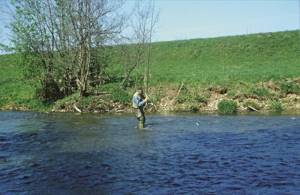
Examination
Some distrustful fishermen have a desire to test the purchased rods themselves. It's easy enough to do. A long fly rod has two critical spots - the third leg from the top and the second leg from the bottom. The third knee from the top is usually designed for a load of up to 0.5 kg, then the thicker knees begin to work actively. Therefore, first, a piece of thick fishing line about 1 m long is tied to the tip of the fishing rod. A load weighing 400–500 g is attached to the free end of the fishing line, the rod is rested with the butt on the floor and slowly, without jerking, it is lifted and placed vertically. In this case, no crunching should be heard.
Anglers often ask the question: “What kind of fish can be lifted on a fishing rod?” I can say with confidence that you simply physically cannot lift a fish weighing more than 1.5 kg from the water using a 7 m long lever. This will also be problematic because the rod will bend into an arc, but the fish will not appear from the water. You can go further and replace the load with a heavier one, for example, weighing 1.5 kg. If the rod does not break when the butt reaches a vertical position, it means that it can catch not only bream and roach, but also carp up to 16 kg. Is there any point in such testing? In my opinion, none. In such a test, at best, you will choose a deliberately heavy “stick” with a huge margin of safety.
It is more correct to test the rod in this way, using exactly the fishing line that you will use during fishing, and attaching a load slightly less than its strength. In this case, you can be sure that even pulling the fish out of the water without a landing net will not lead to damage.
Something else is more important. For example, you make a choice between two rods with the aim of using them when catching kilogram crucian carp. You are planning to use 0.14 mm fishing line (with a margin). Both rods with a length of, say, 7 m are easy to control with equipment weighing 1.5 g. For fast fishing, when the conditions require forcing fishing, it makes sense to take a more powerful model. And if the fish starts to be capricious and during the fishing process you have to use lighter equipment on a thinner line and carefully fish out the fish, then you will need a less powerful rod.

Balance
The vague and collective concept of “action” contains another component, which is called the balance of the rod. This is a quality that affects how you feel when casting, hooking and holding the rod in place. Balance depends on the distribution of the rod's mass along its length and is often interpreted as the location of the center of gravity. The closer the center of gravity is to the hand holding the rod, the more pleasant it is to work. This is correct, but in addition to static balance there is also dynamics. It often happens that when casting with different rods with almost the same location of the centers of gravity, in one case it is comfortable to make a swing, but in another - not so much. It depends on the dynamic stiffness of the middle part of the rod. Therefore, when choosing, take the rod and wave it several times, simulating a hard cast. It’s even better to do this with several models from which you have to choose. Your own feelings turn out to be the most accurate. It’s good if you can make test casts with equipment of medium weight, for example 1.5–2 g.
It is very bad if the rod begins to produce self-oscillations after casting. This is unnoticeable, but quickly leads to hand fatigue. The worst thing is if damped vibrations occur or are transmitted to the rod tip. This can also be assessed during practice swings.
Since the fishing rod cannot be accurately calculated, new models appear based on old good designs using increasingly modern technologies. The optimization process is gradual, and in some cases the old brand is retained, but when technology changes, new names appear.
Of the interesting models, I would highlight four series of Briscola fly rods. I really liked the 5- and 7-meter Fiamma when fishing for carp weighing up to 3 kg, and I recommend the 9-meter Fantasma, which can safely be classified as a sports rod, to anyone who chooses a long rod for catching bream. I did not find any shortcomings in these rods and replaced the “old” model range from “five” to “nine” in my arsenal.
In order for a fishing rod to serve for a long time, you need to take care of it, keep it clean and protect it from impacts, especially from sharp corners. Treat it like a good instrument.
Source: rsn.ru
Interesting article to read:
- Feeder Concept series rods
- Feeder Concept Distance rods – work report…
- Choosing a fishing line for spinning.
- Spinning ultralight selection and review.
- Choosing a reel for Bolognese fishing
